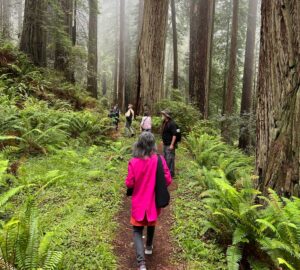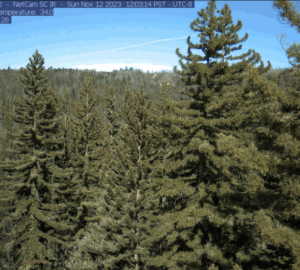League and partners unveil post-fire plan to restore forests in Santa Cruz Mountains
The year 2020 was a wakeup call: On August 16, hundreds of lightning strikes in the Santa Cruz Mountains ignited what would become the CZU Lightning Complex fires. The conflagration burned through the coast redwood forests at a speed, scale, and intensity not seen in the area for several hundred years. And three state parks—Big Basin Redwoods, Año Nuevo, and Butano—were right in its path.
The good news is that most of the resilient, fire-adapted redwoods survived. But four years later, these forests are still recovering. Currently, they have an overabundance of combustible material, including standing dead trees that pose a safety risk for visitors. This accumulation could also feed another devastating fire and threaten the survival of old-growth redwood stands. It’s a pressing problem in need of a solution.
That’s where the power of partnership comes in. Save the Redwoods League has collaborated with California State Parks and a broad coalition of partners to develop a comprehensive Forest Management Strategy that balances ecological restoration with public safety. The newly unveiled plan is designed to not only restore these forests but to improve their climate and wildfire resilience for the long term.
“Restoring these parks is about more than just recovery from fire,” says League director of stewardship and restoration Ben Blom. “It’s about restoring this forest to make sure it’s able to endure future challenges. These are incredible, beloved parks, and we need to take proactive steps to ensure the health and resilience of the forests for the future.”

The report outlines critical actions needed to reduce fuel for wildfires, limit invasive species, and help native plants and animals recover. These science-based techniques include thinning unnaturally dense stands, promoting the growth of larger trees, and using controlled burns to mimic the natural fire patterns that were suppressed in California for well over a century.
“Fire is scary. We tried to not have fire for the last 150 years,” says Tim Hyland, natural resource program manager with California State Parks. “It turns out that we can’t do that in this system. However, if we begin to burn large acreage on a more regular basis, over time the landscape becomes less and less flammable.”
As California State Parks moves forward with the restoration plan, visitors may encounter temporary closures in portions of Big Basin Redwoods, Año Nuevo, and Butano state parks. A short-term inconvenience, considering the potential to safeguard redwoods capable of living for thousands of years.
“Human time scales are puny, and especially in relation to the redwoods,” says Hyland. “We come and we go, but the redwoods are still here.”








